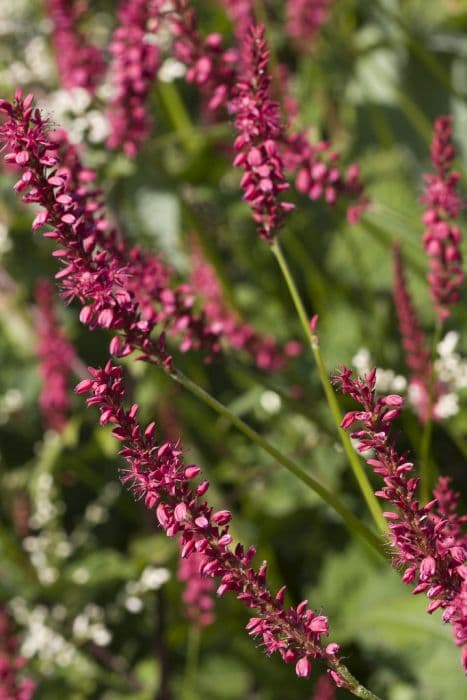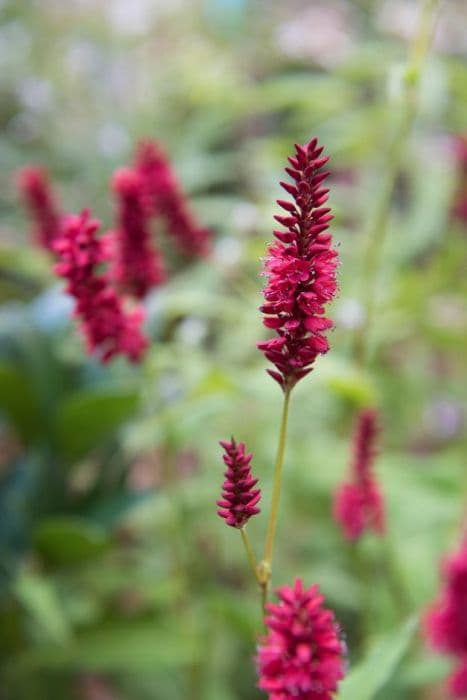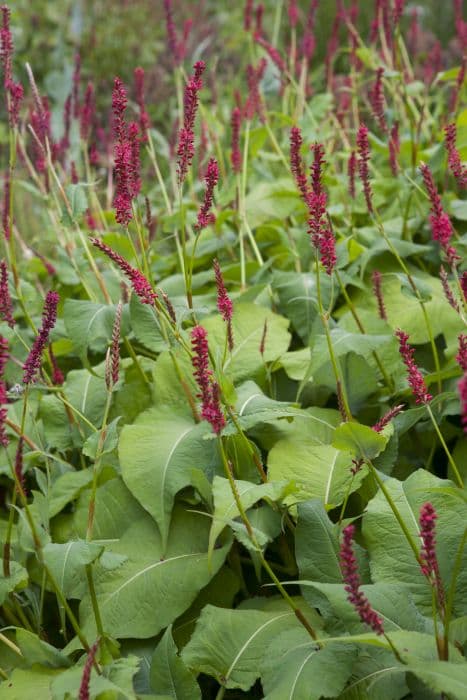Ornamental Rhubarb Rheum 'Ace of Hearts'

ABOUT
Rheum 'Ace of Hearts' is a perennial plant known for its striking foliage and architectural presence in the garden. Its leaves are quite ornamental, emerging in early spring as a deep red hue and transitioning to a greenish-red shade as they mature. The leaves are heart-shaped with a bold texture, underlined by prominent veining that gives them a distinctive appearance. This plant also produces tall, dramatic flower spikes that rise above the foliage in late spring or early summer, featuring small white to pinkish-red flowers that can add vertical interest to a garden setting. The flowers later give way to large winged seeds. While it is a member of the same family as the common rhubarb, it is primarily grown as an ornamental plant rather than for culinary use. The overall impression of Rheum 'Ace of Hearts' in the landscape is one of a vibrant and robust plant, with its colorful leaves and towering flowers providing a visual feast for gardeners and onlookers alike.
About this plant
 Names
NamesFamily
Polygonaceae
Synonyms
Ace of Hearts Rhubarb, Ornamental Rhubarb
Common names
Rheum 'Ace of Hearts'.
 Toxicity
ToxicityTo humans
The Rheum 'Ace of Hearts' is a variety of rhubarb. While the stalks of rhubarb are edible when cooked, the leaves are toxic to humans due to their high concentration of oxalic acid. If someone ingests rhubarb leaves, they might experience symptoms such as a burning sensation in the mouth and throat, difficulty breathing, nausea, vomiting, diarrhea, eye pain, and stomach pain. In severe cases, it can result in kidney failure due to the formation of oxalate crystals which can affect kidney function.
To pets
Rhubarb, including the variety 'Ace of Hearts', is toxic to pets as well. The leaves contain oxalic acid which can cause similar symptoms in pets as in humans, like drooling, loss of appetite, vomiting, diarrhea, lethargy, and weakness. In severe cases, ingestion can lead to kidney failure and even be fatal if not treated promptly. It is important to keep pets away from rhubarb leaves to prevent poisoning.
 Characteristics
CharacteristicsLife cycle
Perennials
Foliage type
Deciduous
Color of leaves
Green
Height
2-3 feet (60-90 cm)
Spread
3-4 feet (90-120 cm)
Plant type
Herb
Hardiness zones
3
Native area
Asia
Benefits
 General Benefits
General Benefits- Aesthetic Appeal: Adds vibrant color and unique foliage to gardens with its heart-shaped leaves and reddish stalks.
- Ease of Care: Relatively low maintenance; requires simple watering and occasional feeding.
- Drought Tolerance: Once established, exhibits some drought resistance, making it suitable for varying climates.
- Seasonal Interest: Offers spring flowers and striking foliage that can change color in the fall.
- Wildlife Attraction: Attracts beneficial insects, such as bees, with its flowers.
- Culinary Use: Stalks are edible and can be used in pies, tarts, and other recipes (Note: only the stalks are edible; the leaves are toxic).
- Soil Enrichment: Can improve soil quality over time by adding organic matter as its leaves decompose.
- Privacy: Its size and density can provide a screen or backdrop, offering a sense of garden seclusion.
 Medical Properties
Medical Properties- This plant is not used for medical purposes.
 Air-purifying Qualities
Air-purifying QualitiesThis plant is not specifically known for air purifying qualities.
 Other Uses
Other Uses- As a natural dye: The large leaves of Rheum 'Ace of Hearts', commonly known as ornamental rhubarb, can be used to produce a greenish-brown color for dyeing fabrics and yarns.
- Insect repellent: The strong scent of ornamental rhubarb might deter certain insects when planted in a garden, making it a natural insect repellent.
- Photography subject: Because of its unique heart-shaped leaves and striking appearance, ornamental rhubarb can serve as an interesting subject for nature photography.
- Garden Sculpture: When dried, the thick and sturdy rhubarb stems can be varnished and used as natural sculptures or garden stakes in the landscape.
- Educational specimen: Ornamental rhubarb can be used in botanical studies and demonstrations due to its interesting growth patterns and plant structure.
- Culinary presentation: Although this variety is not typically eaten, its large leaves can be used as an organic platter or base for presenting other foods at outdoor events.
- Craft material: The fibrous stalks of the ornamental rhubarb can be used in making handmade paper or as a natural fiber in weaving projects.
- Tannin source: Similar to other rhubarb species, the roots of ornamental rhubarb might contain tannins that could be utilized in natural tanning processes.
- Soil erosion control: With its robust root system, ornamental rhubarb can be planted on slopes or areas prone to erosion to help retain soil.
- Potpourri ingredient: Dried fragments of ornamental rhubarb leaves can be incorporated into potpourri mixes to add bulk and texture.
Interesting Facts
 Feng Shui
Feng ShuiThe Ace of Hearts Rhubarb is not used in Feng Shui practice.
 Zodiac Sign Compitability
Zodiac Sign CompitabilityRhubarb is not used in astrology practice.
 Plant Symbolism
Plant Symbolism- Love and Passion: The 'Ace of Hearts' variety of Rhubarb suggests a connection to feelings of deep affection and intense emotion, mirroring the symbolism often associated with heart imagery.
- Good Fortune: In some cultures, an ace in card games is considered a sign of luck, so this plant might be seen as a harbinger of positive things to come.
- Vitality: Rhubarb is known for its vigorous growth and resilience, which can symbolize a robust and energetic life or spirit.
- Protection: Historically, rhubarb has been used medicinally to protect against various ailments, which can extend to symbolic protection in a metaphysical sense.
 Water
WaterThe 'Ace of Hearts' rhubarb should be watered deeply once a week, providing about 1 inch of water to thoroughly moisten the root zone. In hotter seasons or drier climates, increase the frequency to twice per week, ensuring the soil remains consistently moist but not waterlogged. Utilize a soaker hose or drip irrigation for the most effective water delivery, targeting the base of the plant and avoiding overhead watering to minimize leaf wetness and potential disease. During the winter dormancy period, reduce watering significantly, but do not allow the soil to completely dry out.
 Light
Light'Ace of Hearts' rhubarb thrives in full sun to partial shade conditions. Choose a location where the plant will receive at least six hours of sunlight daily. If grown in hotter regions, some afternoon shade can help protect the plant from excessive heat and ensure the best growth and leaf production.
 Temperature
Temperature'Ace of Hearts' rhubarb prefers a cool to moderate climate, with ideal temperature conditions ranging between 40°F and 75°F. It can survive short periods of temperatures as low as 20°F and as high as 90°F, but prolonged exposure to extremes can be detrimental to the plant's health.
 Pruning
PruningPrune the 'Ace of Hearts' rhubarb in late fall or early spring by removing any dead or diseased leaves and stems to maintain the plant's health and vigor. Pruning at this time helps to stimulate new growth in the spring. Always use clean, sharp pruning tools to make clean cuts.
 Cleaning
CleaningAs needed
 Soil
SoilRheum 'Ace of Hearts', commonly known as ornamental rhubarb, thrives in well-draining, fertile soil with a pH around 6.0 to 6.5. A beneficial mix can be created by combining loam, compost, and perlite in equal parts. Fertilize periodically with a balanced fertilizer to maintain plant vigor.
 Repotting
RepottingOrnamental rhubarb should be repotted every 1-2 years or when it outgrows its current pot. Check the root system in the spring and repot with fresh soil mix if necessary, ensuring minimal disturbance to the roots.
 Humidity & Misting
Humidity & MistingOrnamental rhubarb prefers a moderate humidity level but is quite adaptable to different humidity conditions. As long as the soil moisture is well-regulated, ambient humidity typically does not pose an issue for this plant.
 Suitable locations
Suitable locationsIndoor
Ensure bright light, moderate watering, and good air circulation.
Outdoor
Plant in partial sun, amend soil with compost, and mulch annually.
Hardiness zone
3-8 USDA
 Life cycle
Life cycleThe 'Ace of Hearts' rhubarb begins its life cycle when a seed is planted or when a crown is divided and replanted. The seed or crown will germinate or establish in the soil, producing shoots that emerge from the ground as the plant enters a vegetative growth phase, characterized by large, heart-shaped leaves unfurling on red or greenish-red stalks. During its growing season, the rhubarb develops a deep root system and thick, edible petioles. Following vegetative growth, 'Ace of Hearts' rhubarb may produce flower stalks, though these are often removed to encourage leaf and stem production. After harvesting in late spring to early summer, the plant enters a period of dormancy during the colder months. With proper care, including division every few years, 'Ace of Hearts' rhubarb can live and be productive for ten years or more.
 Propogation
PropogationPropogation time
Spring-Early Summer
Rheum 'Ace of Hearts', commonly known as a variety of ornamental rhubarb, is typically propagated by division, as it is the most popular method for this plant. The best time to divide ornamental rhubarb like the 'Ace of Hearts' variety is in early spring as the plant emerges from dormancy, to give it a full growing season to establish. To propagate by division, dig up the parent plant and use either your hands or a sharp, sterile knife to carefully split the crown, ensuring that each division has at least one growth bud. Afterwards, replant the divisions at the same depth they were growing previously and water in well to help reduce transplant shock. Care should be taken to space out the divisions adequately to allow for mature growth; a spacing of about 2 to 3 feet (approximately 60 to 90 centimeters) is common for ornamental rhubarbs to ensure good air circulation and growth.









